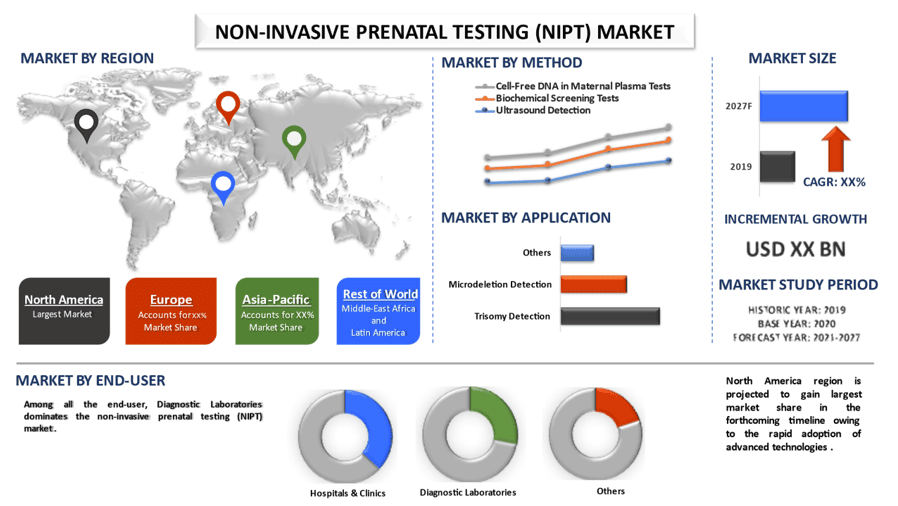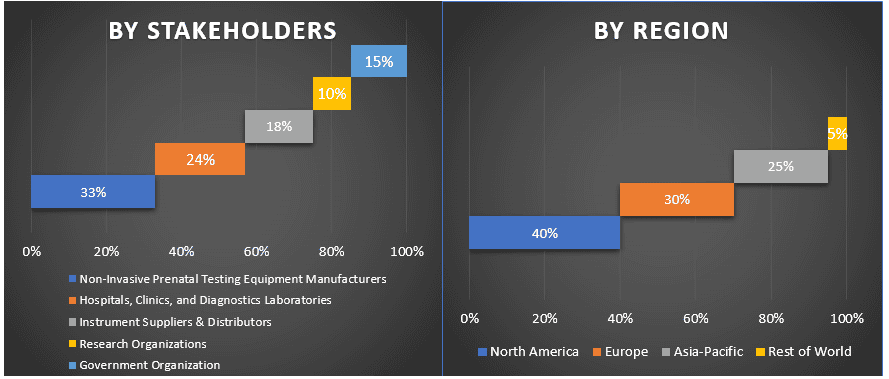Рынок неинвазивного пренатального тестирования (NIPT): текущий анализ и прогноз (2021-2027)
По продукту (Инструменты {Ультразвуковые аппараты, Системы секвенирования нового поколения, Приборы для полимеразной цепной реакции, Микрочипы, Другие}, Расходные материалы {Наборы для анализа и реагенты, Одноразовые материалы}); По методу (Ультразвуковая диагностика, Биохимические скрининговые тесты, Тесты на внеклеточную ДНК в плазме крови матери); По применению (Выявление трисомии, Выявление микроделеций, Другие); По конечному пользователю (Больницы и клиники, Диагностические лаборатории, Другие); Регионы и страны

ЗАПРОСИТЬ БЕСПЛАТНЫЙ ОБРАЗЕЦ PDF
Ожидается, что рынок неинвазивного пренатального тестирования (НИПТ) будет демонстрировать среднегодовой темп роста около 14,7% в течение прогнозируемого периода (2021–2027 гг.). Мутации в генах и хромосомах могут повысить риск генетических аномалий у нерожденного ребенка. Рост распространенности хромосомных аномалий привел к резкому увеличению спроса на надежный инструмент скрининга для пренатальных тестов. Высокий риск хромосомных аномалий с увеличением возраста матери, растущее предпочтение неинвазивных методов инвазивным и улучшение сценария возмещения расходов на НИПТ являются решающими факторами, стимулирующими рост рынка. Несколько устоявшихся игроков, а также новые стартапы ищут финансирование для проведения исследований и клинических испытаний методов НИПТ. Многие правительственные и частные организации внимательно следят за исследовательскими институтами и стартапами для разработки инновационных процедур тестирования для выявления ключевых генетических заболеваний с помощью НИПТ. Например, в июне 2019 года компания Cradle Genomics, стартап из Сан-Диего, привлекла более 17 миллионов долларов США в рамках финансирования серии А, проведенного для поддержки клинической разработки, корпоративной инфраструктуры, операций лаборатории CLIA и коммерческого запуска тестов.
Информация, представленная в отчете
«Среди продуктов сегмент расходных материалов занимал значительную долю рынка в 2020 году»
На основе продукта рынок подразделяется на инструменты и расходные материалы. Сегмент расходных материалов далее подразделяется на наборы для анализа и реагенты, а также одноразовые материалы. Наборы для анализа и реагенты включают гель для ультразвуковой передачи, чистящий раствор и т. д. Одноразовые материалы включают салфетки, вату, перчатки и т. д. Высокий спрос на расходные материалы объясняется тем, что участники рынка представляют новые наборы для тестирования и увеличивается количество лабораторных тестов, проводимых во всем мире. Кроме того, одним из основных факторов, стимулирующих спрос на реагенты и расходные материалы, является увеличение количества исследований и разработок для скрининга генетических нарушений. Технологические достижения в области инструментов, а также расширение сотрудничества между игроками являются другими важными факторами, способствующими глобальному внедрению расходных материалов для выявления аномалий во время беременности.
«Среди методов тесты на внеклеточную ДНК в материнской плазме займут наибольшую долю рынка»
На основе метода рынок подразделяется на ультразвуковое обнаружение, биохимические скрининговые тесты и тесты на внеклеточную ДНК в материнской плазме. Из этих трех тестов на внеклеточную ДНК в материнской плазме занимают наибольшую долю рынка неинвазивного пренатального тестирования (НИПТ). Быстрый рост сегмента можно объяснить технологическими достижениями и усилением инициатив компаний по разработке новых продуктов. Внеклеточная ДНК все чаще используется в дородовой помощи для прогнозирования риска генетических заболеваний с использованием различных генетических анализов. Проводится несколько исследований для продвижения использования тестов, доступных с помощью этого метода. Например, Togneri et al. опубликовали в декабре 2019 года исследование, в котором внедрили и подтвердили НИПТ на основе внеклеточной ДНК в региональной генетической лаборатории Национальной службы здравоохранения (NHS). Исследователи пришли к выводу, что НИПТ на основе cfDNA можно проводить в качестве частного теста у пациентов с низким риском распространенной трисомии или по другим причинам.
«Северная Америка будет доминировать на рынке в течение прогнозируемого периода»
Для лучшего понимания внедрения на рынке неинвазивного пренатального тестирования (НИПТ) рынок анализируется на основе его всемирного присутствия в таких странах, как Северная Америка (США, Канада и остальная часть Северной Америки), Европа (Германия, Франция, Италия, Великобритания и остальная Европа), Азиатско-Тихоокеанский регион (Китай, Япония, Индия, Австралия, Южная Корея, остальная часть Азиатско-Тихоокеанского региона) и остальной мир. В 2020 году регион Северной Америки занимал самую высокую долю рынка на мировом рынке неинвазивного пренатального тестирования (НИПТ). Некоторыми из основных игроков, работающих на рынке, являются Illumina, Inc., Yourgene Health, Natera, F. Hoffmann-La Roche Ltd., PerkinElmer Inc., Laboratory Corporation of America, Eurofins LifeCodexx GmbH, Centogene N.V., Quest Diagnostics Incorporated, Agilent Technologies, Inc.
Причины купить этот отчет:
- Исследование включает в себя анализ размера рынка и прогнозирование, подтвержденный проверенными ключевыми экспертами отрасли
- Отчет представляет собой краткий обзор общих показателей отрасли с первого взгляда
- Отчет охватывает углубленный анализ видных представителей отрасли с основным упором на ключевые финансовые показатели бизнеса, портфель продуктов, стратегии расширения и последние разработки
- Подробное изучение драйверов, ограничений, ключевых тенденций и возможностей, преобладающих в отрасли
- Исследование всесторонне охватывает рынок по различным сегментам
- Углубленный анализ отрасли на региональном уровне
Варианты настройки:
Рынок неинвазивного пренатального тестирования (НИПТ) может быть дополнительно настроен в соответствии с требованиями или любым другим сегментом рынка. Кроме того, UMI понимает, что у вас могут быть свои собственные бизнес-потребности, поэтому не стесняйтесь обращаться к нам, чтобы получить отчет, который полностью соответствует вашим требованиям.
Содержание
Анализ исторического рынка, оценка текущего рынка и прогнозирование будущего рынка неинвазивного пренатального тестирования (NIPT) были тремя основными шагами, предпринятыми для создания и анализа спроса и продаж неинвазивного пренатального тестирования (NIPT) в основных регионах мира. Было проведено исчерпывающее вторичное исследование для сбора исторических данных о рынке и оценки текущего размера рынка. Во-вторых, для подтверждения этих выводов было принято во внимание множество результатов и предположений. Кроме того, были проведены исчерпывающие первичные интервью с экспертами отрасли по всей цепочке создания стоимости отрасли. После предположения и подтверждения рыночных показателей посредством первичных интервью мы применили восходящий подход для прогнозирования общего размера рынка. После этого были приняты методы декомпозиции рынка и триангуляции данных для оценки и анализа размера рынка сегментов и подсегментов, к которым относится отрасль. Подробная методология описана ниже.
Подробнее о методологии исследования
Анализ исторического размера рынка
Шаг 1: Углубленное изучение вторичных источников:
Было проведено подробное вторичное исследование для получения исторических данных о размере рынка неинвазивного пренатального тестирования (NIPT) из внутренних источников компании, таких как годовой отчет и финансовая отчетность, презентации, пресс-релизы и т. д., и внешних источников, включая журналы, новости и статьи, правительственные публикации, публикации конкурентов, отраслевые отчеты, базы данных третьих сторон и другие надежные публикации.
Шаг 2: Сегментация рынка:
После получения исторических данных о размере рынка неинвазивного пренатального тестирования (NIPT) мы провели подробный вторичный анализ для сбора исторических данных о рынке и доли для различных сегментов и подсегментов для основных регионов. Основные сегменты, включенные в отчет, включают продукт, метод, применение и конечного пользователя. Дальнейший анализ на региональном уровне был проведен для оценки общего спроса на неинвазивное пренатальное тестирование (NIPT) в глобальном контексте.
Шаг 3: Факторный анализ:
После получения исторических данных о размере рынка различных сегментов и подсегментов мы провели подробный факторный анализ для оценки текущего размера рынка. Кроме того, мы провели факторный анализ с использованием зависимых и независимых переменных, таких как растущий спрос на продукты для неинвазивного пренатального тестирования (NIPT), такие как пан, ароматизированный супари и пан масала. Были проанализированы исторические тенденции и их ежегодное влияние на размер и долю рынка. Также был тщательно изучен сценарий спроса и предложения.
ЗАПРОСИТЬ ИНДИВИДУАЛЬНУЮ НАСТРОЙКУ
Оценка и прогноз текущего размера рынка
Оценка текущего размера рынка: На основе действенных выводов, полученных на основе вышеуказанных 3 шагов, мы пришли к текущему размеру рынка, ключевым игрокам на рынке и долям рынка сегментов и компаний. Все необходимые процентные разбивки и разбивки рынка были определены с использованием вышеупомянутого вторичного подхода и были проверены посредством первичных интервью.
Оценка и прогнозирование: Для оценки и прогнозирования рынка различным факторам были присвоены веса, включая драйверы и тенденции, ограничения и возможности, доступные для заинтересованных сторон. После анализа этих факторов были применены соответствующие методы прогнозирования, т. е. восходящий подход, чтобы получить прогноз рынка до 2027 года для различных сегментов и подсегментов в основных регионах мира. Методология исследования, принятая для оценки размера рынка, включает в себя:
- Размер рынка отрасли с точки зрения стоимости (доллары США) и спрос на неинвазивное пренатальное тестирование (NIPT) в основных регионах мира
- Все процентные доли, разбивки и разбивки рыночных сегментов и подсегментов
- Ключевые игроки на рынке неинвазивного пренатального тестирования (NIPT) с точки зрения предлагаемых продуктов. Кроме того, стратегии роста, принятые этими игроками для конкуренции на быстрорастущем рынке.
Подтверждение размера и доли рынка
Первичное исследование: Были проведены углубленные интервью с ключевыми лидерами мнений (KOL), включая руководителей высшего звена (CXO/VPs, руководители отдела продаж, руководители отдела маркетинга, руководители операционного отдела и региональные руководители, руководители стран и т. д.) в основных странах. Затем результаты первичных исследований были обобщены, и был проведен статистический анализ для доказательства заявленной гипотезы. Вклад первичных исследований был объединен с вторичными результатами, что превратило информацию в действенные выводы.
Разделение основных участников в разных регионах

Инжиниринг рынка
Метод триангуляции данных был использован для завершения общей оценки рынка и получения точных статистических данных по каждому сегменту и подсегменту рынка неинвазивного пренатального тестирования (NIPT). Данные были разделены на несколько сегментов и подсегментов после изучения различных параметров и тенденций в областях продукта, типа, цвета и регионов.
Основная цель исследования рынка неинвазивного пренатального тестирования (NIPT)
В исследовании точно определены текущие и будущие рыночные тенденции рынка неинвазивного пренатального тестирования (NIPT). Инвесторы могут получить стратегические выводы, чтобы основывать свои решения для инвестиций на основе качественного и количественного анализа, проведенного в исследовании. Текущие и будущие рыночные тенденции определят общую привлекательность рынка на региональном уровне, предоставляя промышленным участникам платформу для использования неиспользованного рынка, чтобы получить выгоду от преимущества первопроходца. Другие количественные цели исследований включают в себя:
- Проанализировать текущий и прогнозируемый размер рынка неинвазивного пренатального тестирования (NIPT) с точки зрения стоимости (доллары США). Также проанализировать текущий и прогнозируемый размер рынка различных сегментов и подсегментов отрасли
- Сегменты в исследовании включают продукт, канал сбыта и регионы
- Определен анализ нормативно-правовой базы для индустрии неинвазивного пренатального тестирования (NIPT)
- Проанализировать цепочку создания стоимости, связанную с присутствием различных посредников, а также проанализировать поведение клиентов и конкурентов, относящееся к отрасли
- Проанализировать текущий и прогнозируемый размер рынка неинвазивного пренатального тестирования (NIPT) по всему миру. Основные регионы, проанализированные в отчете, включают Северную Америку (США, Канада, остальная часть Северной Америки); Европа (Германия, Великобритания, Франция, Италия, остальная часть Европы); Азиатско-Тихоокеанский регион (Китай, Япония, Индия, Австралия, Южная Корея, остальная часть Азиатско-Тихоокеанского региона); и остальной мир. Определить и проанализировать конкурентную среду сектора неинвазивного пренатального тестирования (NIPT) и стратегии роста, принятые участниками рынка для поддержания устойчивости на быстрорастущем рынке
Углубленный анализ отрасли на региональном уровне
Связанные Отчеты
Клиенты, купившие этот товар, также купили










